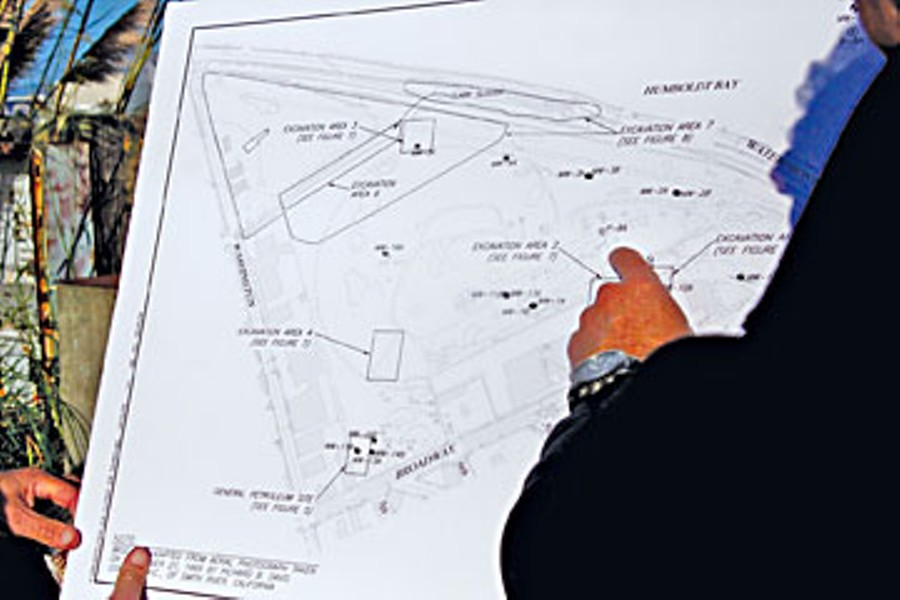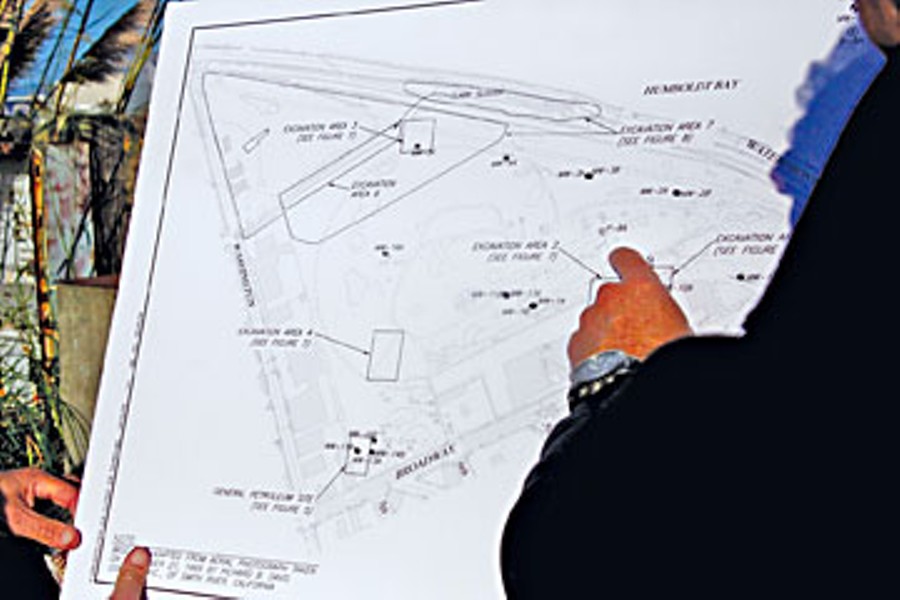Eureka's sprawling 43-acre Balloon Track is, in its current state, a difficult place to picture a bustling 500,000 square foot mini-city with residences, industry, a wetland and a commercial hub anchored by a big-box retailer. It's littered with piles of garbage, islands of broken concrete slabs and the rusty remains of abandoned rail yard structures. Yet owner Rob Arkley's controversial proposal for the property -- which goes by the name of "Marina Center" -- has been steadily approaching a major hurdle: cleaning up the pollutants that make it a brownfield site.
In order to begin the estimated $2 million endeavor, which includes restoration of an 11-acre wetland, permits upon permits must be granted by a number of public agencies. In June, the North Coast Regional Water Quality Control Board approved the Supplemental Interim Remediation Action Plan (SIRAP), which outlines a strategy to clean up contaminants found in testing thus far. This was step one. Permits are also required from the City of Eureka, the Army Corps of Engineers and the Environmental Protection Agency.
But judging from a public tour of the site last week, there's a ton of work to be done. Concrete ruins now overgrown with weeds must be excavated. Rusty remains of old buildings must be removed. Contaminated soil must be cleaned. The wetland must be resurrected, and grading must be done to prevent stormwater from leaching into Humboldt Bay. Mark Ransom of Tampa-based Environmental Resources Management, the company that prepared the SIRAP, said the site is contaminated with petroleum hydrocarbons and heavy metals such as copper and arsenic -- residues of refueling operations at the former railyard.
"This site was, as I like to call it, more like the Jiffy Lube equivalent of a railyard," Ransom said.
Following the tour, Eureka City Councilman Jeff Leonard hosted a forum to discuss the proposed cleanup plan. The majority of the roughly two-hour-long meeting focused on the issue of dioxins, a group of chemicals produced through the combustion process. In former timber industry centers like Humboldt County, dioxins have been found not only in chemicals used to treat lumber but also in locations that housed so-called teepee burners -- a common feature at lumber mills on the North Coast until they were outlawed in the 1980s.
Forum attendees expressed concern that toxic chemical testing on the Balloon Track has been insufficient. There have been only seven tests conducted thus far, and dioxins were present in several cases. Randy Gans, vice president of real estate and development for Security National, an Arkley-owned company, said after the forum that dioxin levels at the Balloon Track are well below Humboldt Bay's largest known dioxin source, Indian Island. "We're not even in the same reality here," Gans said. "This dioxin thing is new, but it's not catastrophic."
Dioxins have been detected elsewhere in Humboldt County, including in stormwater runoff from the streets of Eureka and Arcata, the old Simpson Plywood Mill and GNR Metals. But Caryn Woodhouse, an environmental scientist with the North Coast Regional Water Quality Control Board, said that the ubiquity of dioxins doesn't minimize their toxicity. Of particular concern is 2,3,7,8 Tetrachlorodibenzodioxin, a dioxin found in Agent Orange that can cause a host of health problems in humans including developmental disorders and cancer.
Woodhouse said the primary problem with dioxins is that they become exponentially more concentrated as they travel up the food chain.
"[The Balloon Track] wasn't expected to be a dioxin source based on the history of the site and prior investigation," Woodhouse said. But according to Casey Ashley, a senior engineering geologist with the NCRWQCB, businesses surrounding the Balloon Track could be producing the chemicals through their use of large diesel trucks. And dioxins are indeed present. Select areas -- those where dioxins are suspected -- will be tested, Ashley said. But she added that the prohibitive expense of such studies makes large-scale testing unfeasible.
"My board would shoot me, and they wouldn't even pay for the funeral," she said of ordering that magnitude of tests. "You can spend all your cleanup money on testing alone."
The water board must still approve a final plan after the site has been tested during the initial cleanup process. First, the Eureka Council must decide whether to grant a coastal development permit to Security National on Oct. 20. If the city approves the permit, Gans said they can get to work removing debris piles but would have to wait until May before excavation begins due to laws about such activity during the rainy season. If the city chooses not to grant a permit -- well, it's back to square one.
"Honestly, what can I propose that would be better?" Gans said, adding that the company spent years studying and analyzing the site. "I can't even put my mind in that frame."


Comments (4)
Showing 1-4 of 4